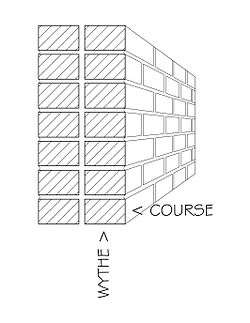Course (architecture)
A course is a layer of the same unit running horizontally in a wall. It can also be defined as a continuous row of any masonry unit such as bricks, concrete masonry units (CMU), stone, shingles, tiles, etc.[1]

Coursed masonry construction is that in which units are arranged in regular courses, and not irregularly. On the other hand, coursed rubble masonry construction is that in which units of random size, that are not cut down, are used to build courses and the in-between spaces are filled with mortar or smaller stones.[1]
If a course is the horizontal arrangement, then a wythe is the vertical section of a wall.[2]
A standard 8-inch CMU block is exactly equal to three courses of brick, so that is it easy to build a brick-on-CMU wall.[3] A bond pattern (or bonding pattern) is the arrangement of several courses. The types of bond patterns can be found under Brickwork.[2] When building a masonry wall the corners are first built and then the spaces between them are filled by the remaining courses.[4]
Orientations
.png)
Masonry coursing can be arranged in various orientations, according to which side of the masonry is facing the outside and how it is positioned.[2]
Stretcher: Units are laid horizontally with their longest end parallel to the face of the wall.[1] This orientation can display the bedding of a masonry stone.
Header: Units are laid on their widest edge so that their shorter ends face the outside of the wall. They overlap four stretchers (two below and two above) and tie them together.[1]
Rowlock: Units laid on their narrowest edge so their shortest edge faces the outside of the wall.[1] These are used for garden walls and for sloping sills under windows, however these are not climate proof.[3]
Soldier: Units are laid vertically on their shortest ends so that their narrowest edge faces the outside of the wall.[1] These are used for window lintels or tops of walls.[3]
Sailor: Units are laid vertically on their shortest ends with their widest edge facing the wall surface.[1]
Shiner or rowlock stretcher: Units are laid on the long narrow side with the broad face of the brick exposed.[5] This orientation can display fossils within a masonry stone.[6]
Types of courses
Different patterns can be used in different parts of a building, some decorative and some structural; this depends on the bond patterns.[2]
Stretcher course (Stretching course): This is a course made up of a row of stretchers.[1] This is the simplest arrangement of masonry units. If the wall is two wythes thick, one header is used to bind the two wythes together. [3]
Header course: This is a course made up of a row of headers.[1]
Bond course: This is a course of headers that bond the facing masonry to the backing masonry.[1]
String course (Belt course or Band course): A horizontal row of masonry, narrower than the other courses, that extends across the façade of a structure or wraps around decorative elements like columns. This is decorative.[1][2][4]
Sill course: Stone masonry courses at the windowsill, projected out from the wall.[1]
Split course: Units are cut down so they are smaller than their normal thickness.[1]
Springing course: Stone masonry on which the first stones of an arch rest.[1]
Starting course: The first course of a unit, usually referring to shingles.[1]
Case course: Units form the foundation or footing course. It is the lowest course in a masonry wall used for multiple functions, mostly structural.[1]
Barge course: Units form the coping of a wall by bricks set on edge.[1]
See also
References
- Harris, Cyril (2006). Dictionary of Architecture and Construction (Forth ed.). United States of America. ISBN 978-0071452373.
- Ballast, David; O'Hara, Steven (2016). ARE 5 Review Manual for the Architect Registration Exam. United States of America: Professional Publications Inc.
- Allen, Edward; Iano, Joseph. Fundamentals of Building Construction (Sixth ed.). Wiley.
- McKee, Harley (1973). Introduction to Early American Masonry. United States: National Trust for Historic Preservation.
- Sovinski, p. 43. "Those brick positions oriented in a horizontal alignment are called stretcher, header, rowlock stretcher, and rowlock. A rowlock stretcher is sometimes called a shiner."
- "Uses of Post Rock Limestone: Building with Post Rocks". www.rushcounty.org. The Rush County Historical Society, Inc. Archived from the original on 2018-09-03. Retrieved 2018-09-02.
… but some evidence suggests that shiners are less resistant to weather. Shiners allowed fossils to be visible on the face, but some evidence suggests that shiners are less resistant to weather.